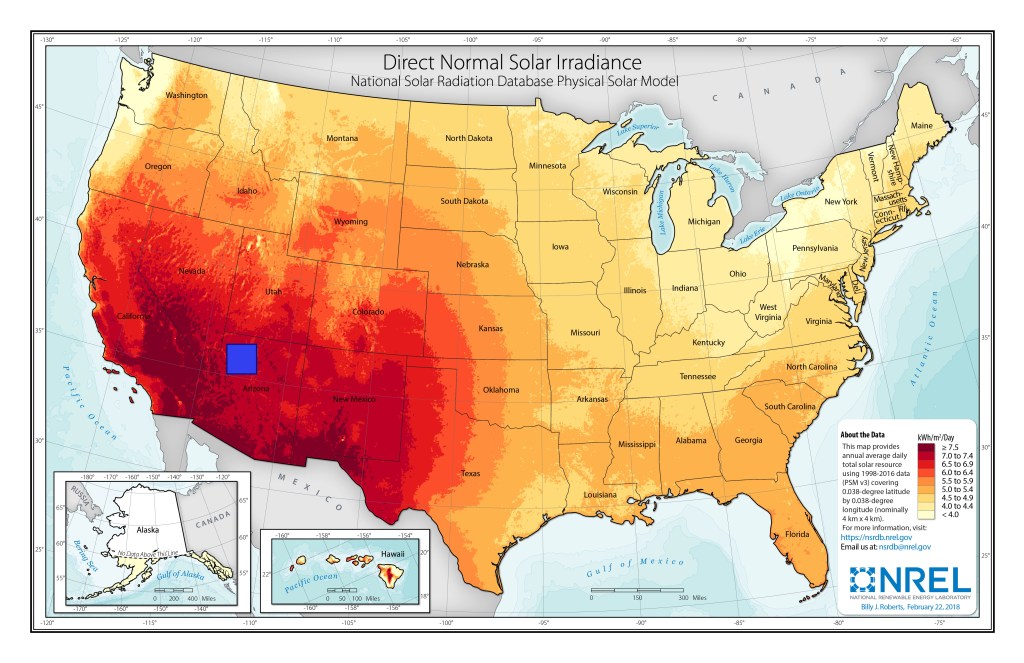Solar power in the desert or on roofs – what are the pros and cons

By Thomas J Taylor, PhD, GAF.
Rooftop solar arrays on commercial buildings offer more realistic alternative to massive solar projects.
It has been said that all of the US could be powered by a solar array covering 100 x 100 square miles in the desert, linked to storage batteries covering 1 x 1 square mile. A similar claim is that covering 0.6% of the nation’s land with solar panels could power the entire country. That is equal to 11,200,000 acres or 17,500 square miles, more than the 10,000 square miles of the first estimate. Obviously, these panels would need to be placed somewhere in the south west, where solar irradiance levels are high and land may be more available:

The blue square represents the size of one such proposed “solar farm,” located in a region of high solar irradiance. At first glance, this might represent a doable project; however, it may require a level of national dedication akin to the efforts to put a man on the moon.
This article will examine some of the assumptions behind these estimates and examine what would happen if similar logic was applied, not to an extremely large ground based solar farm, but to solar installations on commercial buildings. A single large solar farm would require:
- Available land, free of environmental and other regulatory restrictions.
- Infrastructure such as roads, labor, availability of water, and construction materials.
- An electric grid capable of distributing power from what would essentially be a point source, out across the entire nation.
The following picture of a solar farm in the Atacama Desert, Chile, gives an idea of the apparent simplicity of the idea:

The concept seems straight forward, but such a farm needs resources and a work force that might not be readily available on such a grand scale. Alternatively, solar arrays on roofs would represent a distribution of power generation to those locations that actually use it. Also, from a regulatory perspective, solar arrays on rooftops could be simpler and more easily connected to the existing electricity grid. Below is a picture of a large array on the Atlantic City Convention :

To examine the feasibility of supplying all or even a substantial amount of the US electricity demand from solar power, the size of that demand must be known. The first step would be to examine how much power a solar array actually produces versus the currently available energy supply and demand within the US.
US Electricity Demand
- In 2017, according to the US Energy Information Administration, 4,014,804 thousand megawatt hours of electricity were generated.
- The largest demand for this power was for the following uses:
- Residential – 1,378,819 thousand megawatt hours, i.e. 34.3%
- Commercial – 1,349,208 thousand megawatt hours, i.e. 33.6%
- Industrial – 946,443 thousand megawatt hours, i.e. 23.6%
US Electricity Supply
It is beyond the scope of this article to fully analyze how power is generated in the US. However, the following facts are useful for purposes of this article:
- The largest nuclear power plant in the US, located in Palo Verde, Arizona, has a capacity of 3,937 megawatts, or 34,488 thousand megawatt hours of power each year.
- The largest coal fired power plant in the US, located in Juliette, Georgia, has a capacity of 3,520 megawatts, or 30,835 thousand megawatt hours of power each year.
Coal fired and nuclear generators are generally considered as base load plants, running at or close to capacity on a 24/7 basis.
It’s worth noting that renewable sources account for approximately 17% of electricity production in the US, and solar accounts for a little over 1%.
Solar Array Power Production
Solar Farm in the Desert – It is difficult to estimate the amount of power produced by a solar array, because much depends on the location and associate solar irradiation, whether the panels are fixed or track the sun, and other factors. Using data from a wide array of existing solar farms in the US, NREL has estimated that 1,000 megawatt hours of electricity requires on average, 2.8 acres of land installed with panels. This means that a single farm capable of producing all the nation’s electricity would occupy 11,241,451 acres or 17,564.8 square miles. To go back to the beginning of this article, this would be a square 132.5 x 132.5 miles, in line with other estimates.
A solar farm, located in the south west, sized between 100 x 100 and 132.5 x 132.5 square miles could supply all of the US electricity demand.
Commercial Roofing Solar Arrays – Since this analysis is forward looking, this article will use today’s commercial solar panels for the calculations.
- For commercial roof applications, assume each panel is rated at 300 watts, and is 41 x 61 inches (i.e. 2,500 sq. in. or 17.36 sq. ft.).
- The rated power of the panels is produced at peak sunlight, which is normally considered to be the case for 4 to 6 hours each day. For this article, an average of 5 hours was assumed.
- The daily power output of a single panel would therefore be 300 watts x 5 hours or 1,500 watt hours.
- The annual power output for the single panel is therefore 1,500 x 365 days or 547,500 watt-hours or 547.5 kilowatt hours (kWh).
- Solar panels produce direct current and must be linked to a building via an inverter to convert the electricity to alternating current at 120 volts. These are fairly efficient, but to account for these and other system losses, this article assumes an overall efficiency of 90% (i.e. 10% of the produced power is lost between the panel and the user). Therefore, the single panel supplies 547.5 x 0.9 = 492.75 kWhr per year of useful power.
- Commercial roofs cannot be 100% covered with solar panels. Access to those panels and rooftop mechanical units, areas adjacent to the roof edges, and general spacing limit the useful roof area to about 80% coverage.
Examining these numbers to calculate how much power can be obtained from commercial roofs shows that:
- If a 17.36 sq. ft. panel produces 492.75 kWh of useful power per year, then 1 megawatt hour/year (MWhr/yr) would require (17.36 / 492,750) x 1,000,000 / 80% = 44.0589 sq. ft. of roof area.
Commercial Roofs
One possible option in this examination of the potential impact of solar arrays on commercial roofs is to evaluate how much roofing is installed every year. In general, solar arrays work best on large footprint buildings, such as big box stores. This building type commonly uses single-ply membranes, and therefore, are ideal platforms for solar array installations. Also, single ply membranes represent over 60% of the commercial roofing market and are therefore the basis for this first option.
- The annual area of single ply membrane installed is about 2,750 million sq. ft.
- If solar was installed on this area of roofing, using the data calculated above, then it would potentially provide 2,750 x 106 roof sq.ft. / 44.0589 sq.ft/MWhr = 62,416.4 thousand MWhr of power per year.
- This represents the equivalent of:
- Over 2 of the largest coal fired power plants in the US (rated at 30,000 thousand MWhr per year).
If solar panels were installed on all new single ply roofing each year, it would be the equivalent of building two of the largest conventional generating plants each year.
An alternative option would be to look at the total existing low slope commercial roof area in the US. Few estimates exist, but an NREL study published in 2016 suggested the following:
- Medium size buildings, with roof areas of between 5,000 and 25,000 square feet account for a total roof area of 13,132 million square feet.
- Large size buildings, with roof areas of greater than 25,000 square feet account for a total roof area of 21,420 million square feet.
Taken together, this suggests that, excluding small buildings, the total low slope roof area in the US is 34,552 million square feet or 1,239.38 sq.miles. This includes all membrane types.
How much power could be produced if all of those roofs were equipped with solar arrays? Using the same assumptions as before, and based on today’s solar panels:
- If solar was installed on this area of roofing, then it would potentially provide 34,552 x 106 roof sq.ft. / 44.0589 sq.ft./MWhr = 784,000 thousand MWhr/yr of power.
- This would equate to 19.5% of the annual total US electricity demand.
- It would equate to 58.1% of total commercial electricity demand in the US.
Advantages of Roof-Based Solar Power
Roof-based solar power can produce power close to actual demand. As shown above, requiring solar panels on all new single-ply roofing, or better yet, on all existing medium and large sized commercial roofs, would go a long way towards satisfying US electricity demand. Installing solar panels on all new single ply roofing would be equivalent to adding two large conventional power plants each year. Solar power generated from panels installed on all medium and large low slope roofs, would satisfy 58% of the US commercial demand. Granted, it might take a couple of decades to install rooftop solar as we are reroofing our buildings, but the opportunity for long-term renewable energy sources is right above our heads.
Finally, solar power produced on rooftops can be an important part of improving a building’s resilience. When coupled with electric storage, it could be used to power critical parts of a building’s infrastructure for significant periods of time during a storm-caused grid outage.
Learn more about GAF here.
Source: GAF.








-2.png)








Comments
Leave a Reply
Have an account? Login to leave a comment!
Sign In